Analyzing Negotiation Strategies in Human Resource Management
VerifiedAdded on 2023/06/10
|9
|2792
|242
Report
AI Summary
This report delves into the strategies employed by both workers and employers in contract negotiations, particularly focusing on resolving disputes related to pay scales. It examines the principles of contract negotiation, emphasizing the importance of mutual settlement and risk balancing. The strategies adopted by unions, such as collective bargaining and addressing conditions like political and social climate, are discussed. Similarly, employer strategies, including timely negotiation and structured dispute resolution, are analyzed. The report also highlights the conditions employers must adhere to, such as diligence and promoting fair labor practices. It concludes by underscoring the effectiveness of collective bargaining in resolving issues and the importance of strategic negotiation in maintaining positive labor relations. The document is available on Desklib, a platform offering a range of study tools and assignments for students.
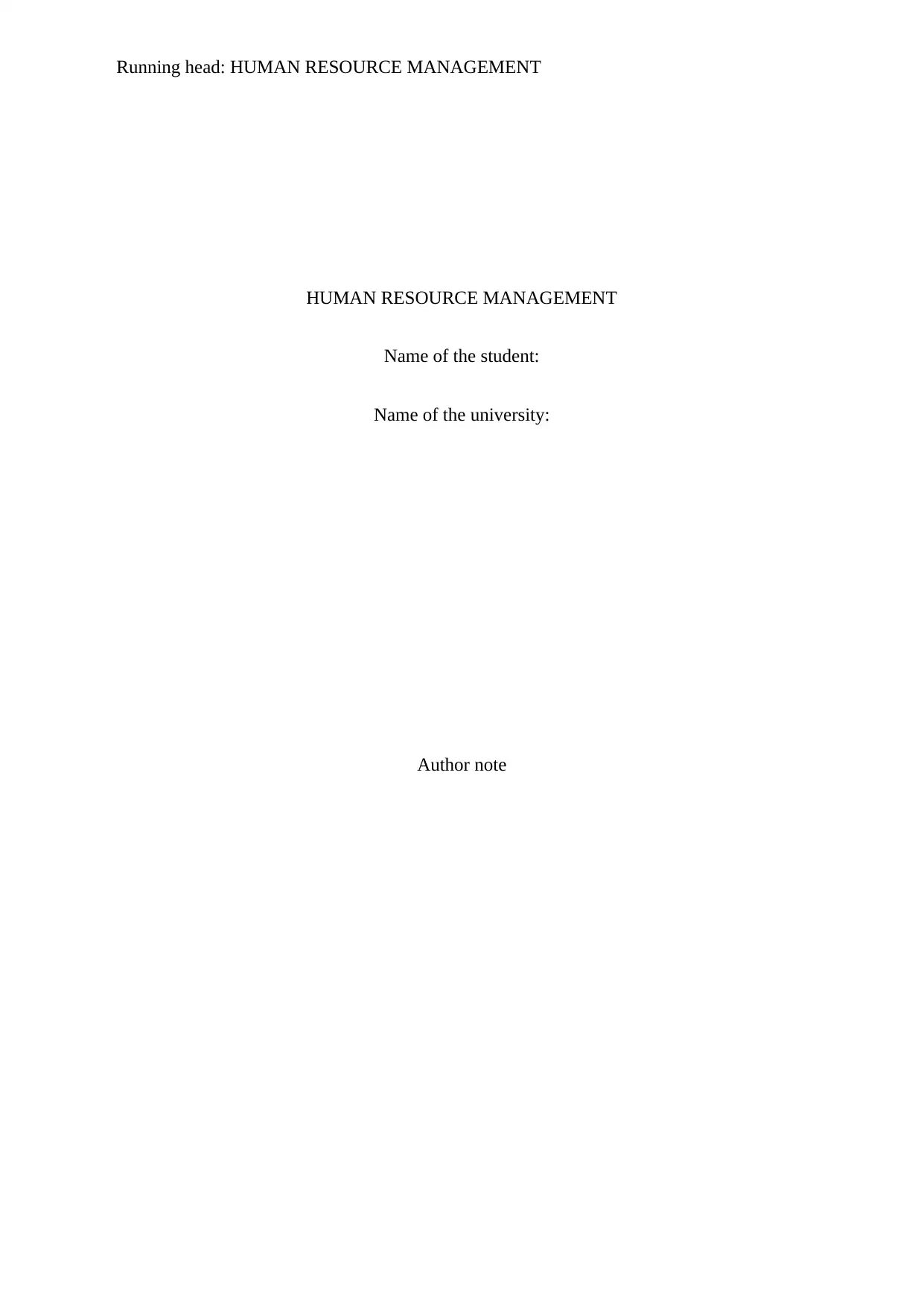
Running head: HUMAN RESOURCE MANAGEMENT
HUMAN RESOURCE MANAGEMENT
Name of the student:
Name of the university:
Author note
HUMAN RESOURCE MANAGEMENT
Name of the student:
Name of the university:
Author note
Paraphrase This Document
Need a fresh take? Get an instant paraphrase of this document with our AI Paraphraser
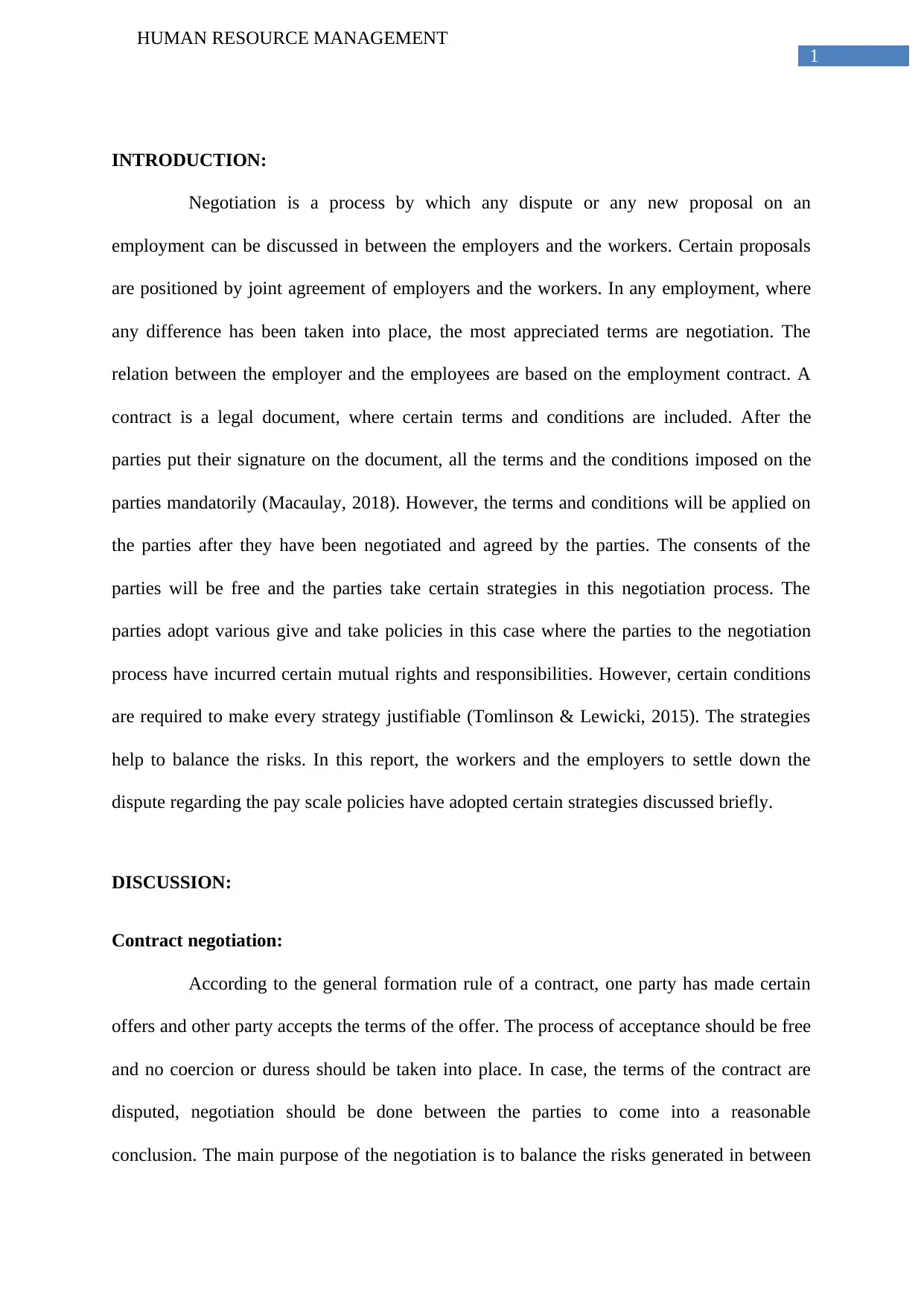
1
HUMAN RESOURCE MANAGEMENT
INTRODUCTION:
Negotiation is a process by which any dispute or any new proposal on an
employment can be discussed in between the employers and the workers. Certain proposals
are positioned by joint agreement of employers and the workers. In any employment, where
any difference has been taken into place, the most appreciated terms are negotiation. The
relation between the employer and the employees are based on the employment contract. A
contract is a legal document, where certain terms and conditions are included. After the
parties put their signature on the document, all the terms and the conditions imposed on the
parties mandatorily (Macaulay, 2018). However, the terms and conditions will be applied on
the parties after they have been negotiated and agreed by the parties. The consents of the
parties will be free and the parties take certain strategies in this negotiation process. The
parties adopt various give and take policies in this case where the parties to the negotiation
process have incurred certain mutual rights and responsibilities. However, certain conditions
are required to make every strategy justifiable (Tomlinson & Lewicki, 2015). The strategies
help to balance the risks. In this report, the workers and the employers to settle down the
dispute regarding the pay scale policies have adopted certain strategies discussed briefly.
DISCUSSION:
Contract negotiation:
According to the general formation rule of a contract, one party has made certain
offers and other party accepts the terms of the offer. The process of acceptance should be free
and no coercion or duress should be taken into place. In case, the terms of the contract are
disputed, negotiation should be done between the parties to come into a reasonable
conclusion. The main purpose of the negotiation is to balance the risks generated in between
HUMAN RESOURCE MANAGEMENT
INTRODUCTION:
Negotiation is a process by which any dispute or any new proposal on an
employment can be discussed in between the employers and the workers. Certain proposals
are positioned by joint agreement of employers and the workers. In any employment, where
any difference has been taken into place, the most appreciated terms are negotiation. The
relation between the employer and the employees are based on the employment contract. A
contract is a legal document, where certain terms and conditions are included. After the
parties put their signature on the document, all the terms and the conditions imposed on the
parties mandatorily (Macaulay, 2018). However, the terms and conditions will be applied on
the parties after they have been negotiated and agreed by the parties. The consents of the
parties will be free and the parties take certain strategies in this negotiation process. The
parties adopt various give and take policies in this case where the parties to the negotiation
process have incurred certain mutual rights and responsibilities. However, certain conditions
are required to make every strategy justifiable (Tomlinson & Lewicki, 2015). The strategies
help to balance the risks. In this report, the workers and the employers to settle down the
dispute regarding the pay scale policies have adopted certain strategies discussed briefly.
DISCUSSION:
Contract negotiation:
According to the general formation rule of a contract, one party has made certain
offers and other party accepts the terms of the offer. The process of acceptance should be free
and no coercion or duress should be taken into place. In case, the terms of the contract are
disputed, negotiation should be done between the parties to come into a reasonable
conclusion. The main purpose of the negotiation is to balance the risks generated in between
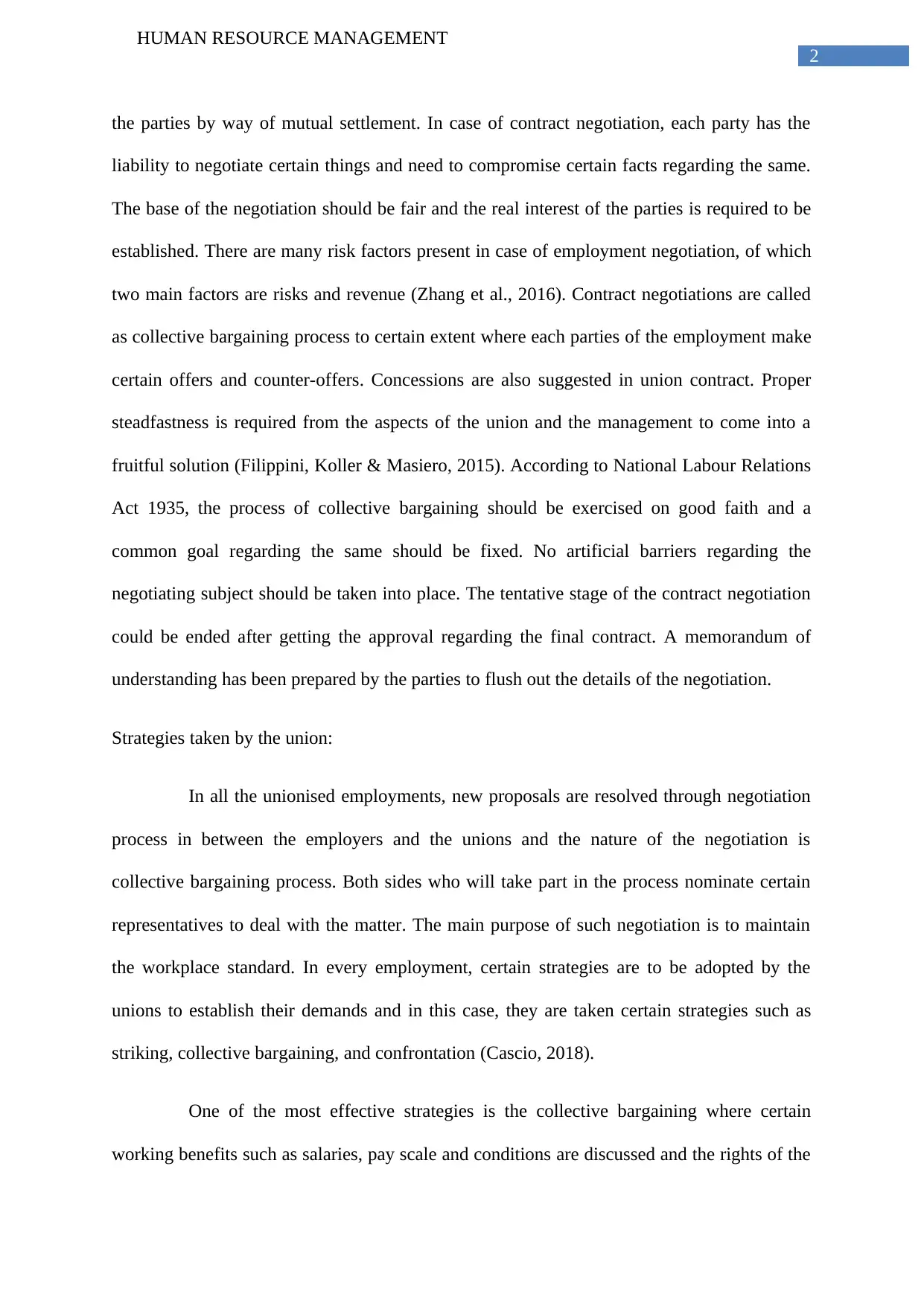
2
HUMAN RESOURCE MANAGEMENT
the parties by way of mutual settlement. In case of contract negotiation, each party has the
liability to negotiate certain things and need to compromise certain facts regarding the same.
The base of the negotiation should be fair and the real interest of the parties is required to be
established. There are many risk factors present in case of employment negotiation, of which
two main factors are risks and revenue (Zhang et al., 2016). Contract negotiations are called
as collective bargaining process to certain extent where each parties of the employment make
certain offers and counter-offers. Concessions are also suggested in union contract. Proper
steadfastness is required from the aspects of the union and the management to come into a
fruitful solution (Filippini, Koller & Masiero, 2015). According to National Labour Relations
Act 1935, the process of collective bargaining should be exercised on good faith and a
common goal regarding the same should be fixed. No artificial barriers regarding the
negotiating subject should be taken into place. The tentative stage of the contract negotiation
could be ended after getting the approval regarding the final contract. A memorandum of
understanding has been prepared by the parties to flush out the details of the negotiation.
Strategies taken by the union:
In all the unionised employments, new proposals are resolved through negotiation
process in between the employers and the unions and the nature of the negotiation is
collective bargaining process. Both sides who will take part in the process nominate certain
representatives to deal with the matter. The main purpose of such negotiation is to maintain
the workplace standard. In every employment, certain strategies are to be adopted by the
unions to establish their demands and in this case, they are taken certain strategies such as
striking, collective bargaining, and confrontation (Cascio, 2018).
One of the most effective strategies is the collective bargaining where certain
working benefits such as salaries, pay scale and conditions are discussed and the rights of the
HUMAN RESOURCE MANAGEMENT
the parties by way of mutual settlement. In case of contract negotiation, each party has the
liability to negotiate certain things and need to compromise certain facts regarding the same.
The base of the negotiation should be fair and the real interest of the parties is required to be
established. There are many risk factors present in case of employment negotiation, of which
two main factors are risks and revenue (Zhang et al., 2016). Contract negotiations are called
as collective bargaining process to certain extent where each parties of the employment make
certain offers and counter-offers. Concessions are also suggested in union contract. Proper
steadfastness is required from the aspects of the union and the management to come into a
fruitful solution (Filippini, Koller & Masiero, 2015). According to National Labour Relations
Act 1935, the process of collective bargaining should be exercised on good faith and a
common goal regarding the same should be fixed. No artificial barriers regarding the
negotiating subject should be taken into place. The tentative stage of the contract negotiation
could be ended after getting the approval regarding the final contract. A memorandum of
understanding has been prepared by the parties to flush out the details of the negotiation.
Strategies taken by the union:
In all the unionised employments, new proposals are resolved through negotiation
process in between the employers and the unions and the nature of the negotiation is
collective bargaining process. Both sides who will take part in the process nominate certain
representatives to deal with the matter. The main purpose of such negotiation is to maintain
the workplace standard. In every employment, certain strategies are to be adopted by the
unions to establish their demands and in this case, they are taken certain strategies such as
striking, collective bargaining, and confrontation (Cascio, 2018).
One of the most effective strategies is the collective bargaining where certain
working benefits such as salaries, pay scale and conditions are discussed and the rights of the
⊘ This is a preview!⊘
Do you want full access?
Subscribe today to unlock all pages.

Trusted by 1+ million students worldwide
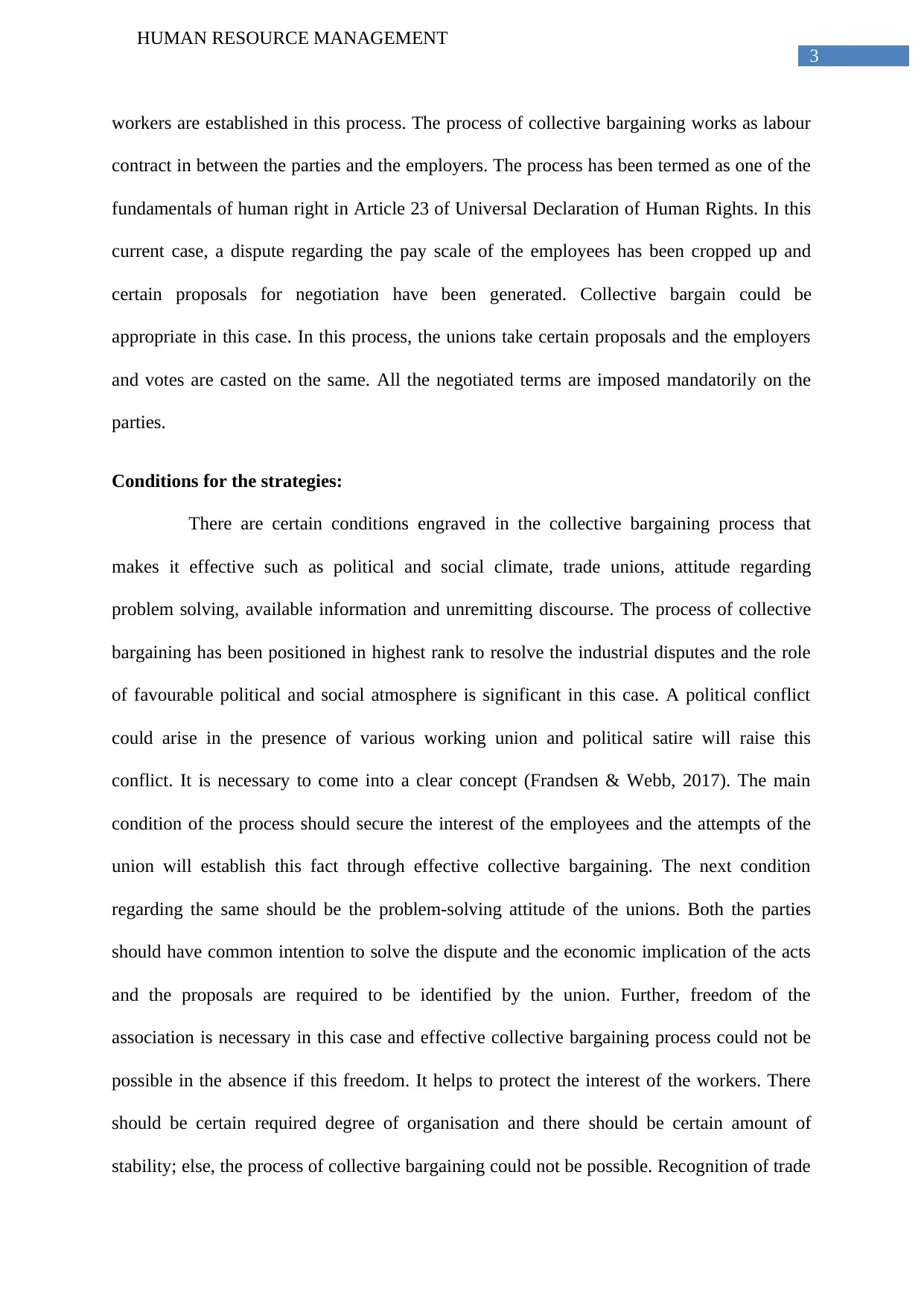
3
HUMAN RESOURCE MANAGEMENT
workers are established in this process. The process of collective bargaining works as labour
contract in between the parties and the employers. The process has been termed as one of the
fundamentals of human right in Article 23 of Universal Declaration of Human Rights. In this
current case, a dispute regarding the pay scale of the employees has been cropped up and
certain proposals for negotiation have been generated. Collective bargain could be
appropriate in this case. In this process, the unions take certain proposals and the employers
and votes are casted on the same. All the negotiated terms are imposed mandatorily on the
parties.
Conditions for the strategies:
There are certain conditions engraved in the collective bargaining process that
makes it effective such as political and social climate, trade unions, attitude regarding
problem solving, available information and unremitting discourse. The process of collective
bargaining has been positioned in highest rank to resolve the industrial disputes and the role
of favourable political and social atmosphere is significant in this case. A political conflict
could arise in the presence of various working union and political satire will raise this
conflict. It is necessary to come into a clear concept (Frandsen & Webb, 2017). The main
condition of the process should secure the interest of the employees and the attempts of the
union will establish this fact through effective collective bargaining. The next condition
regarding the same should be the problem-solving attitude of the unions. Both the parties
should have common intention to solve the dispute and the economic implication of the acts
and the proposals are required to be identified by the union. Further, freedom of the
association is necessary in this case and effective collective bargaining process could not be
possible in the absence if this freedom. It helps to protect the interest of the workers. There
should be certain required degree of organisation and there should be certain amount of
stability; else, the process of collective bargaining could not be possible. Recognition of trade
HUMAN RESOURCE MANAGEMENT
workers are established in this process. The process of collective bargaining works as labour
contract in between the parties and the employers. The process has been termed as one of the
fundamentals of human right in Article 23 of Universal Declaration of Human Rights. In this
current case, a dispute regarding the pay scale of the employees has been cropped up and
certain proposals for negotiation have been generated. Collective bargain could be
appropriate in this case. In this process, the unions take certain proposals and the employers
and votes are casted on the same. All the negotiated terms are imposed mandatorily on the
parties.
Conditions for the strategies:
There are certain conditions engraved in the collective bargaining process that
makes it effective such as political and social climate, trade unions, attitude regarding
problem solving, available information and unremitting discourse. The process of collective
bargaining has been positioned in highest rank to resolve the industrial disputes and the role
of favourable political and social atmosphere is significant in this case. A political conflict
could arise in the presence of various working union and political satire will raise this
conflict. It is necessary to come into a clear concept (Frandsen & Webb, 2017). The main
condition of the process should secure the interest of the employees and the attempts of the
union will establish this fact through effective collective bargaining. The next condition
regarding the same should be the problem-solving attitude of the unions. Both the parties
should have common intention to solve the dispute and the economic implication of the acts
and the proposals are required to be identified by the union. Further, freedom of the
association is necessary in this case and effective collective bargaining process could not be
possible in the absence if this freedom. It helps to protect the interest of the workers. There
should be certain required degree of organisation and there should be certain amount of
stability; else, the process of collective bargaining could not be possible. Recognition of trade
Paraphrase This Document
Need a fresh take? Get an instant paraphrase of this document with our AI Paraphraser
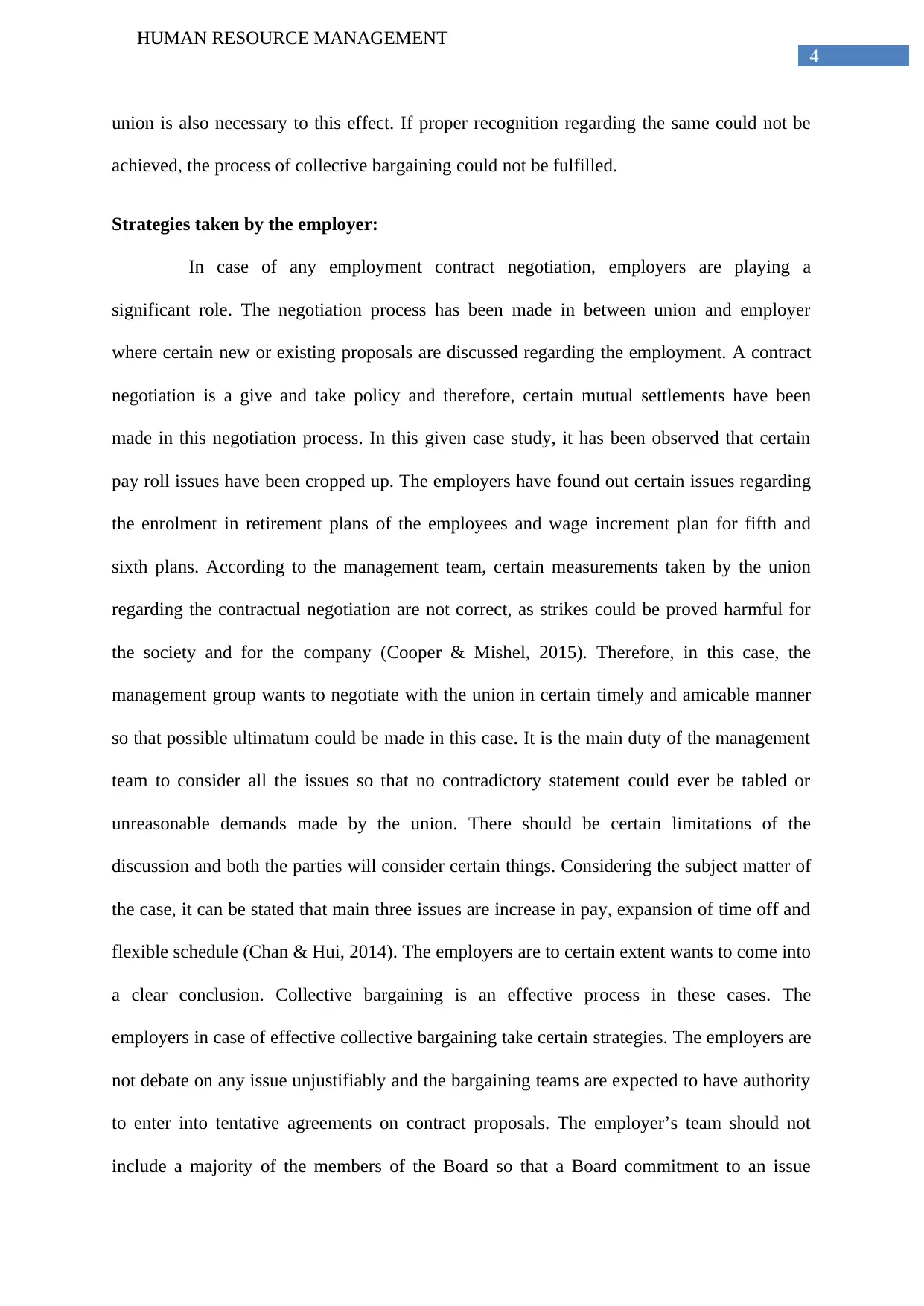
4
HUMAN RESOURCE MANAGEMENT
union is also necessary to this effect. If proper recognition regarding the same could not be
achieved, the process of collective bargaining could not be fulfilled.
Strategies taken by the employer:
In case of any employment contract negotiation, employers are playing a
significant role. The negotiation process has been made in between union and employer
where certain new or existing proposals are discussed regarding the employment. A contract
negotiation is a give and take policy and therefore, certain mutual settlements have been
made in this negotiation process. In this given case study, it has been observed that certain
pay roll issues have been cropped up. The employers have found out certain issues regarding
the enrolment in retirement plans of the employees and wage increment plan for fifth and
sixth plans. According to the management team, certain measurements taken by the union
regarding the contractual negotiation are not correct, as strikes could be proved harmful for
the society and for the company (Cooper & Mishel, 2015). Therefore, in this case, the
management group wants to negotiate with the union in certain timely and amicable manner
so that possible ultimatum could be made in this case. It is the main duty of the management
team to consider all the issues so that no contradictory statement could ever be tabled or
unreasonable demands made by the union. There should be certain limitations of the
discussion and both the parties will consider certain things. Considering the subject matter of
the case, it can be stated that main three issues are increase in pay, expansion of time off and
flexible schedule (Chan & Hui, 2014). The employers are to certain extent wants to come into
a clear conclusion. Collective bargaining is an effective process in these cases. The
employers in case of effective collective bargaining take certain strategies. The employers are
not debate on any issue unjustifiably and the bargaining teams are expected to have authority
to enter into tentative agreements on contract proposals. The employer’s team should not
include a majority of the members of the Board so that a Board commitment to an issue
HUMAN RESOURCE MANAGEMENT
union is also necessary to this effect. If proper recognition regarding the same could not be
achieved, the process of collective bargaining could not be fulfilled.
Strategies taken by the employer:
In case of any employment contract negotiation, employers are playing a
significant role. The negotiation process has been made in between union and employer
where certain new or existing proposals are discussed regarding the employment. A contract
negotiation is a give and take policy and therefore, certain mutual settlements have been
made in this negotiation process. In this given case study, it has been observed that certain
pay roll issues have been cropped up. The employers have found out certain issues regarding
the enrolment in retirement plans of the employees and wage increment plan for fifth and
sixth plans. According to the management team, certain measurements taken by the union
regarding the contractual negotiation are not correct, as strikes could be proved harmful for
the society and for the company (Cooper & Mishel, 2015). Therefore, in this case, the
management group wants to negotiate with the union in certain timely and amicable manner
so that possible ultimatum could be made in this case. It is the main duty of the management
team to consider all the issues so that no contradictory statement could ever be tabled or
unreasonable demands made by the union. There should be certain limitations of the
discussion and both the parties will consider certain things. Considering the subject matter of
the case, it can be stated that main three issues are increase in pay, expansion of time off and
flexible schedule (Chan & Hui, 2014). The employers are to certain extent wants to come into
a clear conclusion. Collective bargaining is an effective process in these cases. The
employers in case of effective collective bargaining take certain strategies. The employers are
not debate on any issue unjustifiably and the bargaining teams are expected to have authority
to enter into tentative agreements on contract proposals. The employer’s team should not
include a majority of the members of the Board so that a Board commitment to an issue
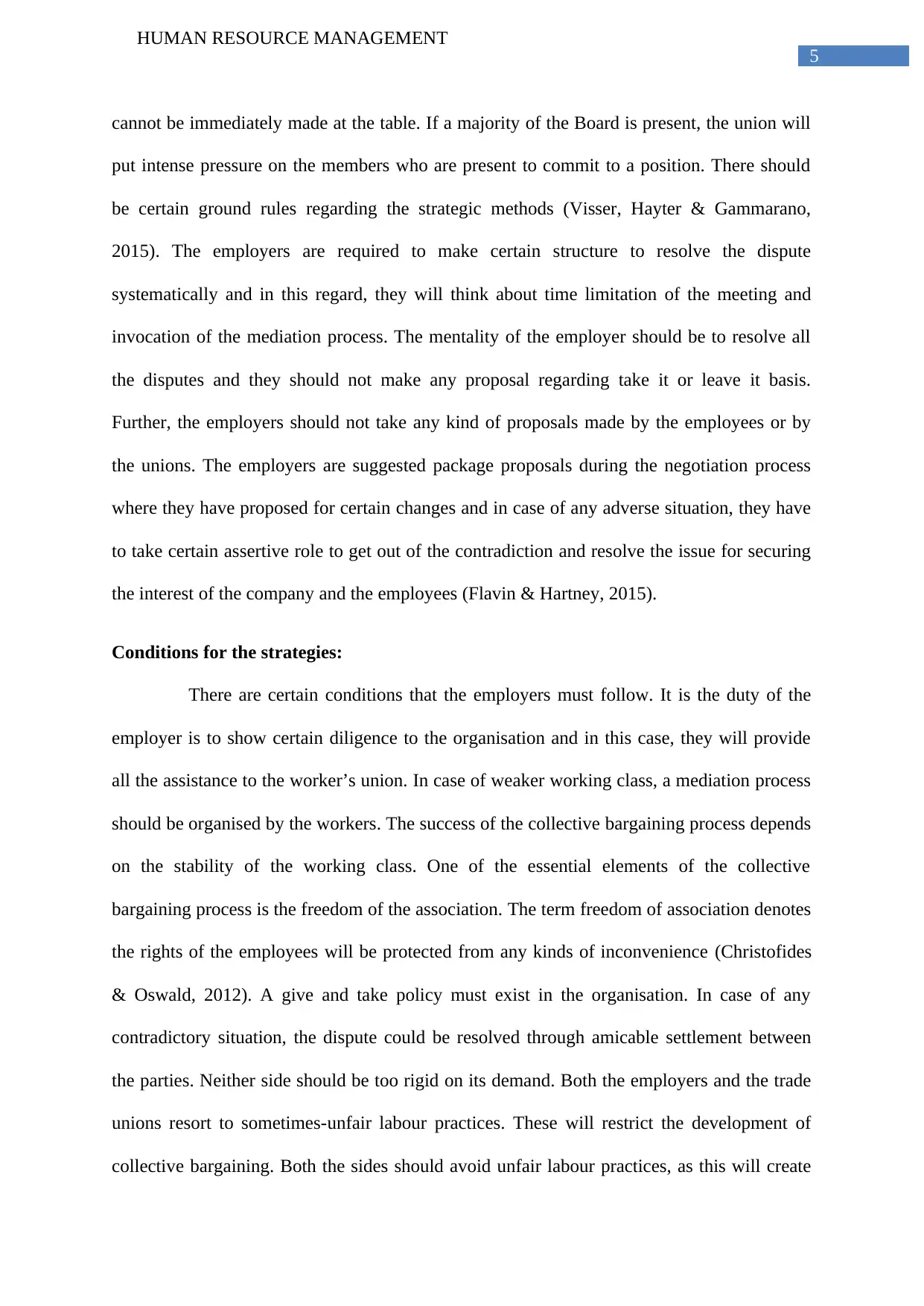
5
HUMAN RESOURCE MANAGEMENT
cannot be immediately made at the table. If a majority of the Board is present, the union will
put intense pressure on the members who are present to commit to a position. There should
be certain ground rules regarding the strategic methods (Visser, Hayter & Gammarano,
2015). The employers are required to make certain structure to resolve the dispute
systematically and in this regard, they will think about time limitation of the meeting and
invocation of the mediation process. The mentality of the employer should be to resolve all
the disputes and they should not make any proposal regarding take it or leave it basis.
Further, the employers should not take any kind of proposals made by the employees or by
the unions. The employers are suggested package proposals during the negotiation process
where they have proposed for certain changes and in case of any adverse situation, they have
to take certain assertive role to get out of the contradiction and resolve the issue for securing
the interest of the company and the employees (Flavin & Hartney, 2015).
Conditions for the strategies:
There are certain conditions that the employers must follow. It is the duty of the
employer is to show certain diligence to the organisation and in this case, they will provide
all the assistance to the worker’s union. In case of weaker working class, a mediation process
should be organised by the workers. The success of the collective bargaining process depends
on the stability of the working class. One of the essential elements of the collective
bargaining process is the freedom of the association. The term freedom of association denotes
the rights of the employees will be protected from any kinds of inconvenience (Christofides
& Oswald, 2012). A give and take policy must exist in the organisation. In case of any
contradictory situation, the dispute could be resolved through amicable settlement between
the parties. Neither side should be too rigid on its demand. Both the employers and the trade
unions resort to sometimes-unfair labour practices. These will restrict the development of
collective bargaining. Both the sides should avoid unfair labour practices, as this will create
HUMAN RESOURCE MANAGEMENT
cannot be immediately made at the table. If a majority of the Board is present, the union will
put intense pressure on the members who are present to commit to a position. There should
be certain ground rules regarding the strategic methods (Visser, Hayter & Gammarano,
2015). The employers are required to make certain structure to resolve the dispute
systematically and in this regard, they will think about time limitation of the meeting and
invocation of the mediation process. The mentality of the employer should be to resolve all
the disputes and they should not make any proposal regarding take it or leave it basis.
Further, the employers should not take any kind of proposals made by the employees or by
the unions. The employers are suggested package proposals during the negotiation process
where they have proposed for certain changes and in case of any adverse situation, they have
to take certain assertive role to get out of the contradiction and resolve the issue for securing
the interest of the company and the employees (Flavin & Hartney, 2015).
Conditions for the strategies:
There are certain conditions that the employers must follow. It is the duty of the
employer is to show certain diligence to the organisation and in this case, they will provide
all the assistance to the worker’s union. In case of weaker working class, a mediation process
should be organised by the workers. The success of the collective bargaining process depends
on the stability of the working class. One of the essential elements of the collective
bargaining process is the freedom of the association. The term freedom of association denotes
the rights of the employees will be protected from any kinds of inconvenience (Christofides
& Oswald, 2012). A give and take policy must exist in the organisation. In case of any
contradictory situation, the dispute could be resolved through amicable settlement between
the parties. Neither side should be too rigid on its demand. Both the employers and the trade
unions resort to sometimes-unfair labour practices. These will restrict the development of
collective bargaining. Both the sides should avoid unfair labour practices, as this will create
⊘ This is a preview!⊘
Do you want full access?
Subscribe today to unlock all pages.

Trusted by 1+ million students worldwide
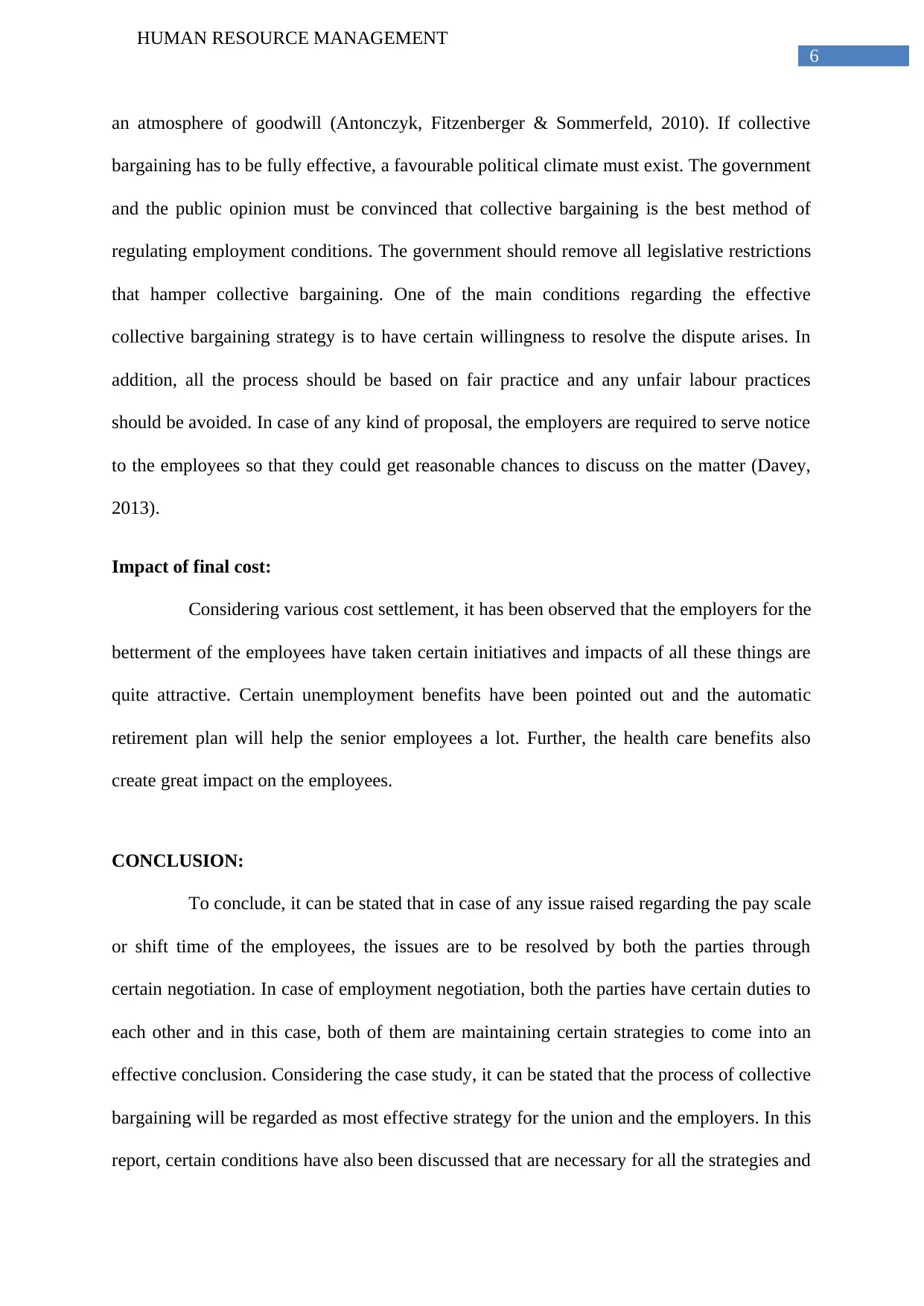
6
HUMAN RESOURCE MANAGEMENT
an atmosphere of goodwill (Antonczyk, Fitzenberger & Sommerfeld, 2010). If collective
bargaining has to be fully effective, a favourable political climate must exist. The government
and the public opinion must be convinced that collective bargaining is the best method of
regulating employment conditions. The government should remove all legislative restrictions
that hamper collective bargaining. One of the main conditions regarding the effective
collective bargaining strategy is to have certain willingness to resolve the dispute arises. In
addition, all the process should be based on fair practice and any unfair labour practices
should be avoided. In case of any kind of proposal, the employers are required to serve notice
to the employees so that they could get reasonable chances to discuss on the matter (Davey,
2013).
Impact of final cost:
Considering various cost settlement, it has been observed that the employers for the
betterment of the employees have taken certain initiatives and impacts of all these things are
quite attractive. Certain unemployment benefits have been pointed out and the automatic
retirement plan will help the senior employees a lot. Further, the health care benefits also
create great impact on the employees.
CONCLUSION:
To conclude, it can be stated that in case of any issue raised regarding the pay scale
or shift time of the employees, the issues are to be resolved by both the parties through
certain negotiation. In case of employment negotiation, both the parties have certain duties to
each other and in this case, both of them are maintaining certain strategies to come into an
effective conclusion. Considering the case study, it can be stated that the process of collective
bargaining will be regarded as most effective strategy for the union and the employers. In this
report, certain conditions have also been discussed that are necessary for all the strategies and
HUMAN RESOURCE MANAGEMENT
an atmosphere of goodwill (Antonczyk, Fitzenberger & Sommerfeld, 2010). If collective
bargaining has to be fully effective, a favourable political climate must exist. The government
and the public opinion must be convinced that collective bargaining is the best method of
regulating employment conditions. The government should remove all legislative restrictions
that hamper collective bargaining. One of the main conditions regarding the effective
collective bargaining strategy is to have certain willingness to resolve the dispute arises. In
addition, all the process should be based on fair practice and any unfair labour practices
should be avoided. In case of any kind of proposal, the employers are required to serve notice
to the employees so that they could get reasonable chances to discuss on the matter (Davey,
2013).
Impact of final cost:
Considering various cost settlement, it has been observed that the employers for the
betterment of the employees have taken certain initiatives and impacts of all these things are
quite attractive. Certain unemployment benefits have been pointed out and the automatic
retirement plan will help the senior employees a lot. Further, the health care benefits also
create great impact on the employees.
CONCLUSION:
To conclude, it can be stated that in case of any issue raised regarding the pay scale
or shift time of the employees, the issues are to be resolved by both the parties through
certain negotiation. In case of employment negotiation, both the parties have certain duties to
each other and in this case, both of them are maintaining certain strategies to come into an
effective conclusion. Considering the case study, it can be stated that the process of collective
bargaining will be regarded as most effective strategy for the union and the employers. In this
report, certain conditions have also been discussed that are necessary for all the strategies and
Paraphrase This Document
Need a fresh take? Get an instant paraphrase of this document with our AI Paraphraser
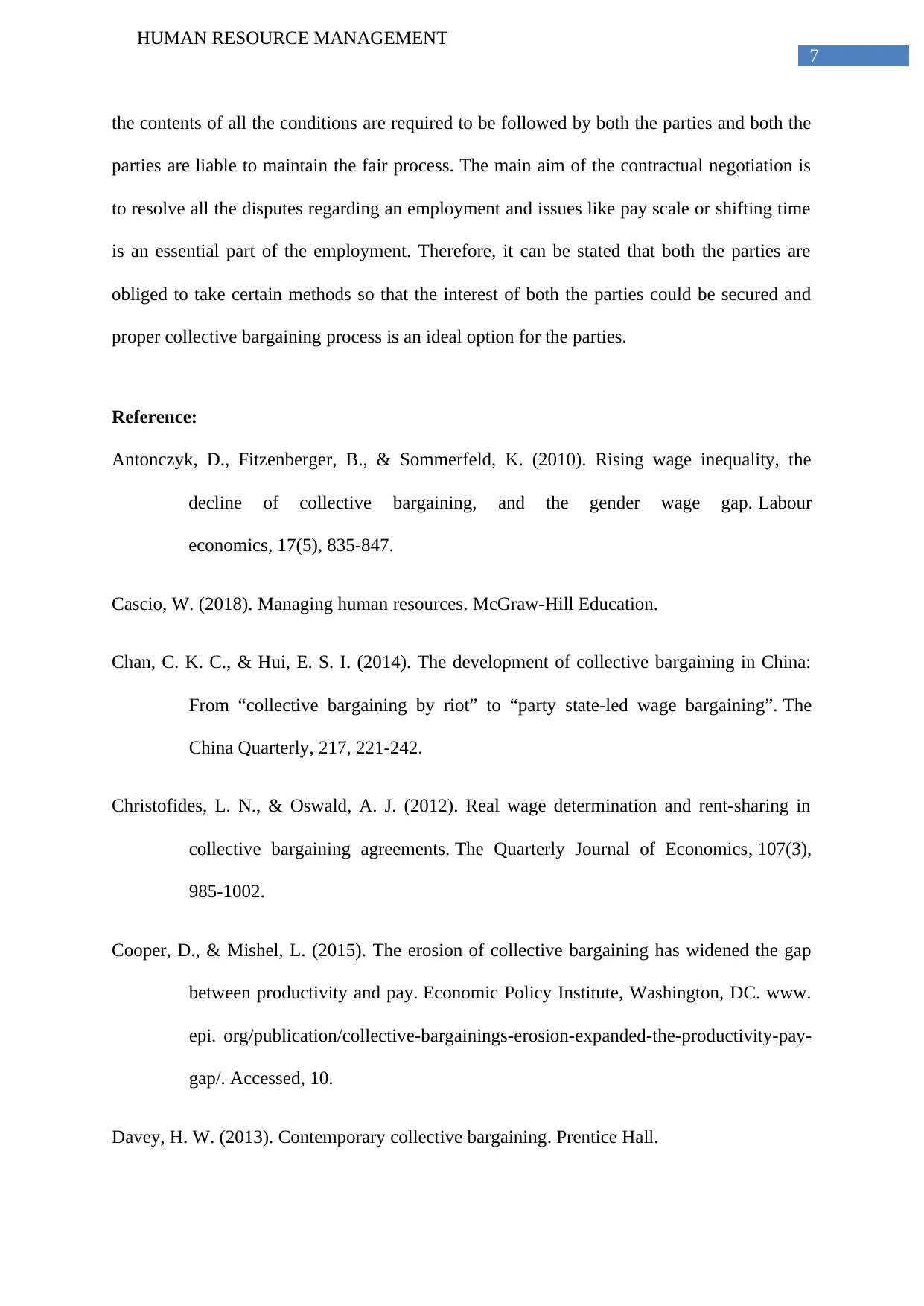
7
HUMAN RESOURCE MANAGEMENT
the contents of all the conditions are required to be followed by both the parties and both the
parties are liable to maintain the fair process. The main aim of the contractual negotiation is
to resolve all the disputes regarding an employment and issues like pay scale or shifting time
is an essential part of the employment. Therefore, it can be stated that both the parties are
obliged to take certain methods so that the interest of both the parties could be secured and
proper collective bargaining process is an ideal option for the parties.
Reference:
Antonczyk, D., Fitzenberger, B., & Sommerfeld, K. (2010). Rising wage inequality, the
decline of collective bargaining, and the gender wage gap. Labour
economics, 17(5), 835-847.
Cascio, W. (2018). Managing human resources. McGraw-Hill Education.
Chan, C. K. C., & Hui, E. S. I. (2014). The development of collective bargaining in China:
From “collective bargaining by riot” to “party state-led wage bargaining”. The
China Quarterly, 217, 221-242.
Christofides, L. N., & Oswald, A. J. (2012). Real wage determination and rent-sharing in
collective bargaining agreements. The Quarterly Journal of Economics, 107(3),
985-1002.
Cooper, D., & Mishel, L. (2015). The erosion of collective bargaining has widened the gap
between productivity and pay. Economic Policy Institute, Washington, DC. www.
epi. org/publication/collective-bargainings-erosion-expanded-the-productivity-pay-
gap/. Accessed, 10.
Davey, H. W. (2013). Contemporary collective bargaining. Prentice Hall.
HUMAN RESOURCE MANAGEMENT
the contents of all the conditions are required to be followed by both the parties and both the
parties are liable to maintain the fair process. The main aim of the contractual negotiation is
to resolve all the disputes regarding an employment and issues like pay scale or shifting time
is an essential part of the employment. Therefore, it can be stated that both the parties are
obliged to take certain methods so that the interest of both the parties could be secured and
proper collective bargaining process is an ideal option for the parties.
Reference:
Antonczyk, D., Fitzenberger, B., & Sommerfeld, K. (2010). Rising wage inequality, the
decline of collective bargaining, and the gender wage gap. Labour
economics, 17(5), 835-847.
Cascio, W. (2018). Managing human resources. McGraw-Hill Education.
Chan, C. K. C., & Hui, E. S. I. (2014). The development of collective bargaining in China:
From “collective bargaining by riot” to “party state-led wage bargaining”. The
China Quarterly, 217, 221-242.
Christofides, L. N., & Oswald, A. J. (2012). Real wage determination and rent-sharing in
collective bargaining agreements. The Quarterly Journal of Economics, 107(3),
985-1002.
Cooper, D., & Mishel, L. (2015). The erosion of collective bargaining has widened the gap
between productivity and pay. Economic Policy Institute, Washington, DC. www.
epi. org/publication/collective-bargainings-erosion-expanded-the-productivity-pay-
gap/. Accessed, 10.
Davey, H. W. (2013). Contemporary collective bargaining. Prentice Hall.
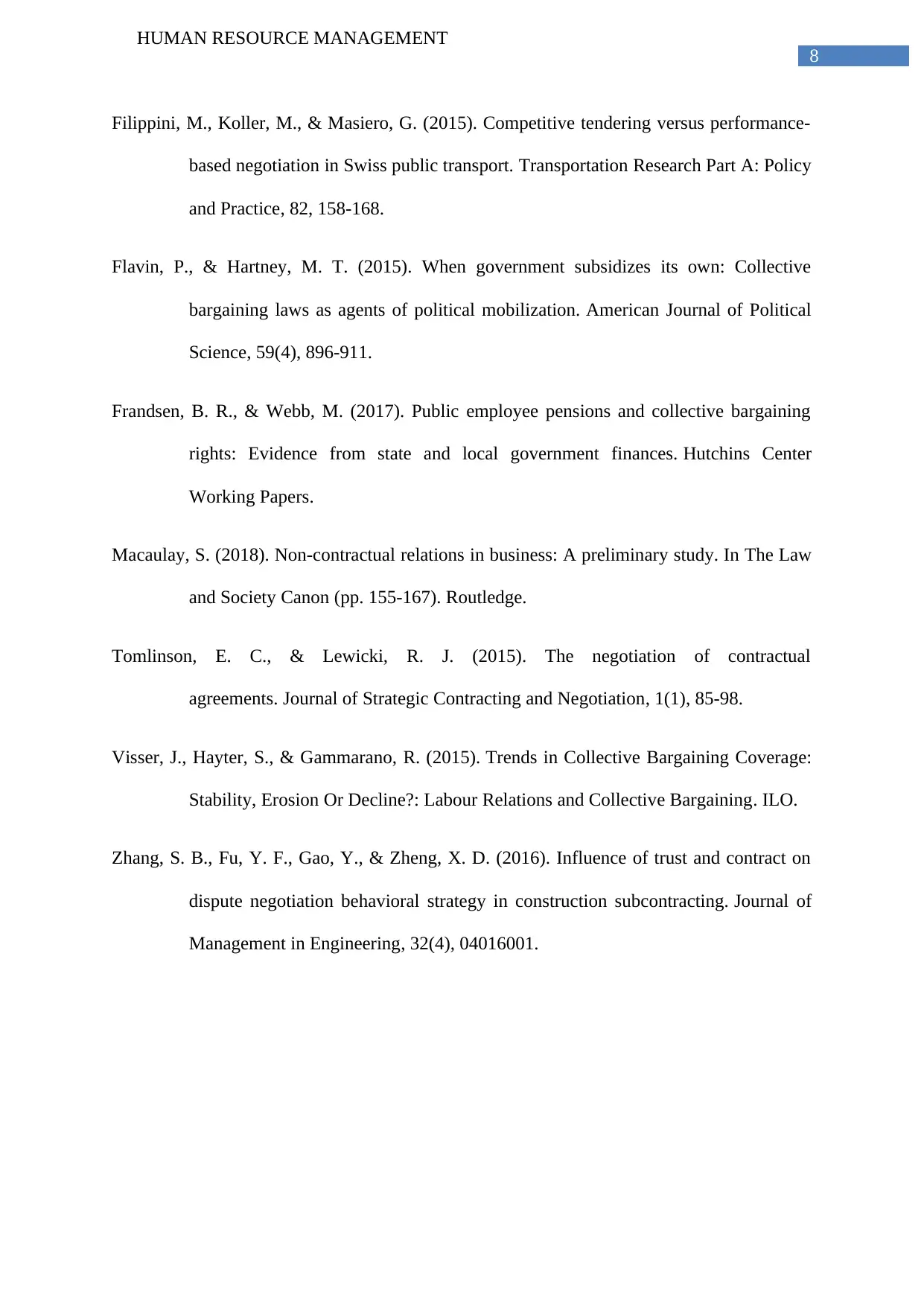
8
HUMAN RESOURCE MANAGEMENT
Filippini, M., Koller, M., & Masiero, G. (2015). Competitive tendering versus performance-
based negotiation in Swiss public transport. Transportation Research Part A: Policy
and Practice, 82, 158-168.
Flavin, P., & Hartney, M. T. (2015). When government subsidizes its own: Collective
bargaining laws as agents of political mobilization. American Journal of Political
Science, 59(4), 896-911.
Frandsen, B. R., & Webb, M. (2017). Public employee pensions and collective bargaining
rights: Evidence from state and local government finances. Hutchins Center
Working Papers.
Macaulay, S. (2018). Non-contractual relations in business: A preliminary study. In The Law
and Society Canon (pp. 155-167). Routledge.
Tomlinson, E. C., & Lewicki, R. J. (2015). The negotiation of contractual
agreements. Journal of Strategic Contracting and Negotiation, 1(1), 85-98.
Visser, J., Hayter, S., & Gammarano, R. (2015). Trends in Collective Bargaining Coverage:
Stability, Erosion Or Decline?: Labour Relations and Collective Bargaining. ILO.
Zhang, S. B., Fu, Y. F., Gao, Y., & Zheng, X. D. (2016). Influence of trust and contract on
dispute negotiation behavioral strategy in construction subcontracting. Journal of
Management in Engineering, 32(4), 04016001.
HUMAN RESOURCE MANAGEMENT
Filippini, M., Koller, M., & Masiero, G. (2015). Competitive tendering versus performance-
based negotiation in Swiss public transport. Transportation Research Part A: Policy
and Practice, 82, 158-168.
Flavin, P., & Hartney, M. T. (2015). When government subsidizes its own: Collective
bargaining laws as agents of political mobilization. American Journal of Political
Science, 59(4), 896-911.
Frandsen, B. R., & Webb, M. (2017). Public employee pensions and collective bargaining
rights: Evidence from state and local government finances. Hutchins Center
Working Papers.
Macaulay, S. (2018). Non-contractual relations in business: A preliminary study. In The Law
and Society Canon (pp. 155-167). Routledge.
Tomlinson, E. C., & Lewicki, R. J. (2015). The negotiation of contractual
agreements. Journal of Strategic Contracting and Negotiation, 1(1), 85-98.
Visser, J., Hayter, S., & Gammarano, R. (2015). Trends in Collective Bargaining Coverage:
Stability, Erosion Or Decline?: Labour Relations and Collective Bargaining. ILO.
Zhang, S. B., Fu, Y. F., Gao, Y., & Zheng, X. D. (2016). Influence of trust and contract on
dispute negotiation behavioral strategy in construction subcontracting. Journal of
Management in Engineering, 32(4), 04016001.
⊘ This is a preview!⊘
Do you want full access?
Subscribe today to unlock all pages.

Trusted by 1+ million students worldwide
1 out of 9
Related Documents
Your All-in-One AI-Powered Toolkit for Academic Success.
+13062052269
info@desklib.com
Available 24*7 on WhatsApp / Email
![[object Object]](/_next/static/media/star-bottom.7253800d.svg)
Unlock your academic potential
Copyright © 2020–2025 A2Z Services. All Rights Reserved. Developed and managed by ZUCOL.





